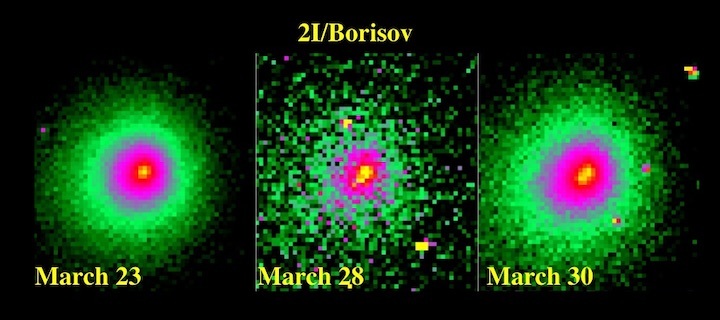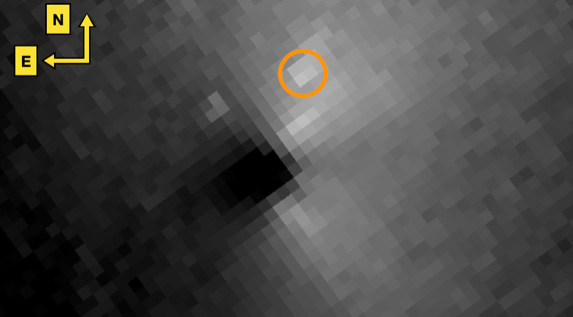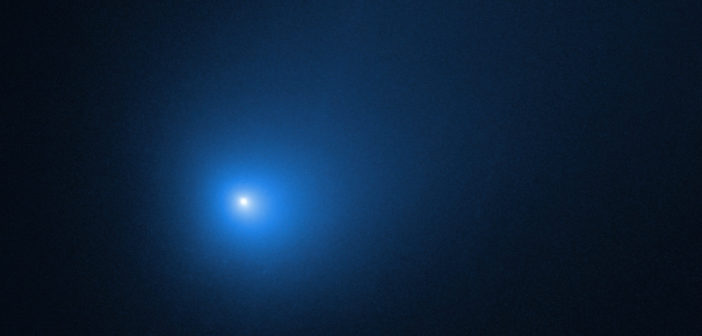7.04.2020
New observations of the interstellar comet have revealed that it’s fragmenting.
The interstellar comet 2I/Borisov, discovered on its way into the solar system in 2019, began shedding chunks in late March — more than three months after its closest approach to the Sun on December 8th.
Recent observations show that the center of Comet Borisov appears to have split: On March 23rd, 28th, and 30th, images recorded by the Hubble Space Telescope show that the comet’s core changed from a single bright spot into an elongated area, where two unresolved objects lie about 180 kilometers (112 miles) apart.
In other words, the images show a small piece of the comet breaking off and drifting slowly away, write David Jewitt (University of California, Los Angeles) and colleagues in The Astronomer's Telegram. If the split started on March 23rd, the drift is about 0.3 meter/second (0.7 mph). 
New images of Comet Borisov show that the core of the comet changed in appearance, from a bright core to a more elongated one.
What’s more, this split isn’t the only one: After processing the same Hubble images to increase the contrast between the core and the coma around it, Bryce Bolin (Caltech) and colleagues spotted a second piece about 540 km from the center of the comet, breaking away at a speed of at least 0.5 m/s. He suggests, also in The Astronomer’s Telegram, that the fragment may have split from the comet during a March 7th outburst, which brightened the comet by 0.7 magnitude.

Bolin et al. / The Astronomers Telegram
Is this the beginning of the end for our second recorded interstellar visitor?
IS BREAKUP IMMINENT?
"Why the comet would start to break up now is strange," says Bolin. Comets native to our solar system are most likely to lose pieces or disintegrate when they are closest to the Sun. Comet Borisov passed 2 astronomical units (a.u.) from the Sun at perihelion, and it spent six months within 3 a.u. of the Sun, where sunlight can vaporize water as well as other ices.
Yet comets differ widely, and fragmentation is possible at the comet's current distance of 3 a.u.
Before perihelion, Jewitt's analysis of Hubble images showed that Comet Borisov is much smaller than had been thought. The comet’s nucleus is not directly visible, but in the January 10th Astrophysical Journal Letters, Jewitt put its diameter between 0.4 and 1 kilometer. That's small enough that solar vaporization of surface ices on the side facing the Sun could spin up its rotation beyond gravity’s ability to hold it together.

NASA / ESA / D. Jewitt (UCLA)
However, the comet’s size is tricky to estimate, as its surface appears to be emitting so much gas and dust that it obscures the nucleus. The fragment that Jewitt observed is about as bright as the comet itself, but because its surface is so icy and active, he thinks the fragment's mass is less than 1% of the whole comet. That would make the split more like a side mirror dropping off a car than a car falling apart. Why the fragment split from the comet is unclear, but possibilities include thermal vaporization after new material was exposed, as well as the force from the comet’s spin if it’s spinning as fast as Jewitt suggests.
The fragment Bolin reports is farther from the comet, pushed away from the Sun by solar vaporization of ices. It was absent in images from February 24th, but appeared in data from March 23 – 28. He estimated its size as no more than 100 meters across based on its visibility, but like Jewitt he did not have a direct measurement.
FRAGMENTATION, YES. BREAKUP? MAYBE
The fragment provides evidence that "the comet is undergoing a fragmentation event," Bolin says, but the event has yet to destroy the nucleus. "When comets catastrophically disrupt, their brightness drops very, very quickly . . . we're not seeing that with Borisov," he explains.
Comets are notoriously tricky to predict. Jewitt says that a rotation period of four hours or less could cause the nucleus to disrupt. Bolin says his analysis of Hubble data shows a period of about 10 hours in December, but the speed may have increased since then. We'll have to wait to see what happens.
"Nobody knows where it came from and how long it's been out there," says Jewitt. We know Borisov was moving about 33 kilometers per second (74,000 mph) when it was discovered, so it would take 100,000 years to cross one light-year. But with only months of orbital data, we lack enough information to trace its path backwards across untold distances to its birthplace.
Bolin says the comet appears to have been little altered before it arrived at our solar system. It may have a narrow escape on the way out.
Quelle: Sky&Telescope
